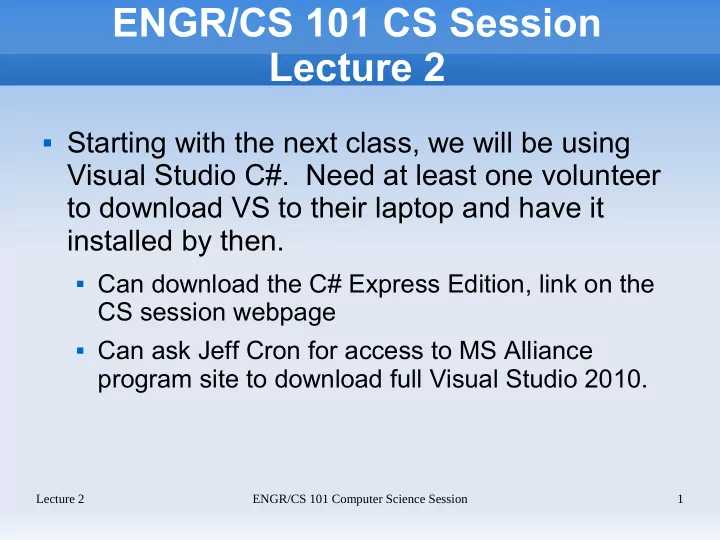

ENGR/CS 101 CS Session Lecture 2 Starting with the next class, we will be using Visual Studio C#. Need at least one volunteer to download VS to their laptop and have it installed by then. Can download the C# Express Edition, link on the CS session webpage Can ask Jeff Cron for access to MS Alliance program site to download full Visual Studio 2010. Lecture 2 ENGR/CS 101 Computer Science Session 1
Outline Software life cycle Problem: How to send a secret message? Codes and ciphers Substitution ciphers Lecture 2 ENGR/CS 101 Computer Science Session 2
Software Life Cycle Specification of the problem/task Analysis and design of a solution Implementation (coding) of the solution Testing and debugging Maintenance and evolution of the system Obsolescence Lecture 2 ENGR/CS 101 Computer Science Session 3
Problem: How to send a secret message? Steganography ("concealed writing"): science of sending concealed messages. Includes physical concealment like invisible ink, microdots... Cryptography ("hidden writing"): how to obscure message so it cannot be read even if intercepted. Use codes and ciphers. Lecture 2 ENGR/CS 101 Computer Science Session 4
Codes and Ciphers Code : whole words or phrases replaced by a word, letter, or a number. Like an alien language; uses translation code book. Cipher : individual letters are replaced by other letters or symbols. Plaintext : message in normal language Ciphertext : message in secret form Lecture 2 ENGR/CS 101 Computer Science Session 5
Ciphers Transposition cipher: rearrange letters of message. Scytale: strip of writing material wrapped around a dowel; write message across dowel. Block: arrange message into a block, rewrite vertical lines Substitution cipher: replace letters with other letters Lecture 2 ENGR/CS 101 Computer Science Session 6
Cipher = Algorithm + Key Algorithm : a series of well-defined steps that can be followed as a procedure. Key : auxiliary information used by an algorithm. Different keys produce different ciphers using the same algorithm. Lecture 2 ENGR/CS 101 Computer Science Session 7
Caesar Shift Cipher Algorithm: substitute a letter with the letter n places to the right Key: letter to shift 'A' to that is n places to the right. E.g. A -> I is shifting 8 places to the right: A B C D E F G H I J K L M I J K L M N O P Q R S T U N O P Q R S T U V W X Y Z V W X Y Z A B C D E F G H Lecture 2 ENGR/CS 101 Computer Science Session 8
In-class Exercise Practice enciphering and deciphering using Caesar shift cipher. Turn in at the end of class. Lecture 2 ENGR/CS 101 Computer Science Session 9
What if the key is unknown? How many possible keys are there for the Caesar Shift Cipher? Lecture 2 ENGR/CS 101 Computer Science Session 10
What if the key is unknown? 26 . (If we include A->A as a possible key.) Small enough that we could try each one in a short amount of time. Lecture 2 ENGR/CS 101 Computer Science Session 11
Polyalphabetic Ciphers Make cipher harder to break by using multiple substitution alphabets Vigenere cipher: key is a "word" rather than just a single letter. Algorithm is to use the key letters to change Caesar cipher shift key for each letter of plaintext. E.g. for key = "LION", encipher first letter with key A->L, encipher second letter with key A->I, etc. Lecture 2 ENGR/CS 101 Computer Science Session 12
Polyalphabetic Ciphers Suppose we allow any letter to be substituted by any other letter? The key would a substitution table mapping each letter to another letter. How many possible keys are there for this cipher? Lecture 2 ENGR/CS 101 Computer Science Session 13
Polyalphabetic Ciphers 26! = 403 291 461 126 605 635 484 000 000 . Over 400 million billion billion. Just how big is this number? 6.5 billion people on Earth; 31 million seconds in a year. If everyone on Earth checked one key per second, ... Lecture 2 ENGR/CS 101 Computer Science Session 14
400 million billion billion It still would take around 2 billion years to check them all! We can conclude that checking every possible key is not a feasible way of trying to decipher an arbitrary substitution cipher. Lecture 2 ENGR/CS 101 Computer Science Session 15
A better way to decipher English letter frequency: E, T, A, O, ... Common words: "the", "and", ... One/two letter words: "I", "a", "to", "of", ... Repeated letters Context Lecture 2 ENGR/CS 101 Computer Science Session 16
Enigma Machine Random substitution cipher represented using a code wheel. Originally 3 code wheels, later 5 wheels Instead of always starting with same letter on wheel as A, just encipher the current letter of plaintext with the next letter on wheel Add a plugboard to further randomize. Lecture 2 ENGR/CS 101 Computer Science Session 17
Recommend
More recommend